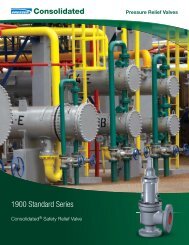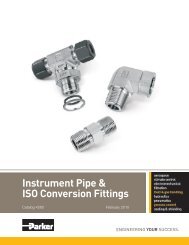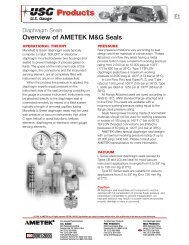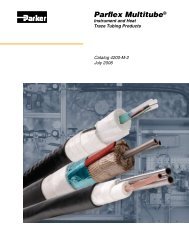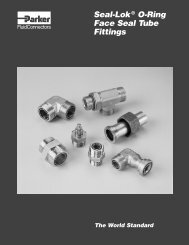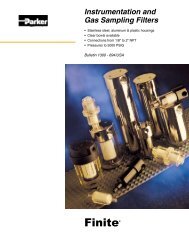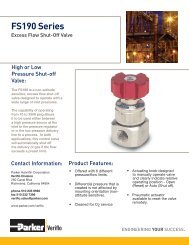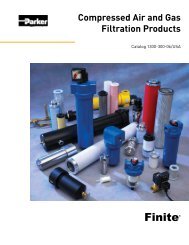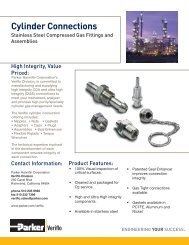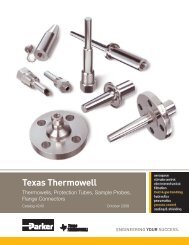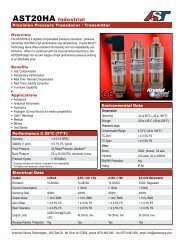Create successful ePaper yourself
Turn your PDF publications into a flip-book with our unique Google optimized e-Paper software.
4300 Catalog <strong>ParKlamp</strong> <strong>Inch</strong> <strong>Tube</strong> <strong>Clamps</strong><br />
Introduction<br />
The <strong>ParKlamp</strong> system is designed for restraining tube, pipe and<br />
hose assemblies to dampen unwanted and potentially harmful<br />
effects of mechanical shock and vibration forces that are common<br />
in fluid power systems.<br />
The clamping system is the most commonly overlooked aspect<br />
of fluid power system design. Failure to properly restrain the<br />
fluid conductors can result in leakage, downtime and system<br />
malfunction, as well as significantly reduce the life of tube, pipe<br />
and hose assemblies. With the <strong>ParKlamp</strong> system, the risk of<br />
problems resulting from mechanical shock and vibration can be<br />
significantly reduced.<br />
Design and Construction<br />
Weld Plate Assembly<br />
Fig. P1 – Weld Plate<br />
Assembly<br />
Mounting Rail Assembly<br />
Fig. P2 – Mounting Rail<br />
Assembly<br />
Designed to meet the basic envelope dimensions of DIN 3015,<br />
Part 1, the <strong>ParKlamp</strong> plastic clamp halves are interchangeable<br />
with the Parker metric clamp system. The primary difference<br />
between these two clamping systems is the utilization of inch,<br />
as opposed to metric, thread hardware in the <strong>ParKlamp</strong> system.<br />
All plastic clamp halves in the <strong>ParKlamp</strong> system are<br />
manufactured from Polypropylene material. The hardware portion<br />
of the <strong>ParKlamp</strong> system is available in plated steel and<br />
stainless steel.<br />
For convenience, the <strong>ParKlamp</strong> system is divided into three<br />
different series: Standard, Heavy and Twin. Each series has<br />
corresponding components, physical dimensions and mechanical<br />
properties. Within each series, there are a number of<br />
groups, each with specific envelope dimensions. Components<br />
from different series and/or groups can not be intermixed.<br />
However, the standard and twin series can be mounting on the<br />
same mounting rail.<br />
How It Works<br />
The <strong>ParKlamp</strong> system has two primary methods for mounting:<br />
weld plates and mounting rails.<br />
<strong>Clamps</strong> should be mounted to a rigid structure for optimum<br />
performance. Clamping tube, pipe or hose assemblies<br />
together without mounting them to a rigid structure, often<br />
called “floating clamps,” does not provide adequate support.<br />
Proper design of a clamping system requires that the<br />
clamps be positioned appropriately on the tube, pipe or<br />
hose assemblies. See the Assembly and Installation section<br />
of this catalog for more information on clamp location<br />
and spacing.<br />
Weld Plate Mounting (Fig. P1)<br />
The weld plate mounting system allows the user to attach a<br />
single clamp assembly to a structure of similar material (steel to<br />
steel, etc) by welding the components together. Once the weld<br />
plate is attached to a structure, one clamp halve can be placed<br />
onto the weld plate, followed by the tube, pipe or hose assembly.<br />
Next, the second plastic clamp halve can be placed on the<br />
tube, pipe or hose assembly, followed by the cover plate (or<br />
Insert). To complete the assembly, the Hex Head attachment<br />
bolts are inserted into the assembly and tightened to the torque<br />
shown in the Assembly section of this catalog.<br />
Mounting Rail Mounting (Fig. P2)<br />
Use of a mounting rail is another way to assemble the clamping<br />
system components onto a support structure. Using a mounting<br />
rail allows multiple clamps to be mounted side-by-side for<br />
restraining a group of tube, pipe, or hose assemblies. The<br />
mounting rail also provides the ability to move the location of the<br />
clamps in one direction for easier alignment. The rail can be<br />
attached to a support structure by welding or bolting. Once the<br />
mounting rail is in place, rail nuts can be slid into the rail. The first<br />
clamp halve, followed by the tube, pipe or hose assembly, can<br />
then be installed over the corresponding rail nuts. After this, the<br />
second clamp half, the cover plate (or Insert) and the hex head<br />
attachment bolts can be installed to complete the assembly.<br />
Stacking (Fig. P3)<br />
A primary feature of the <strong>ParKlamp</strong> system is its ability to<br />
accommodate stacking of a series of clamps to various heights,<br />
thus requiring a smaller footprint for mounting. To do this,<br />
simply use the stacking bolts to mount the first clamp assembly,<br />
then install a stacking plate over the first clamp and stacking<br />
bolts. The second clamp assembly can then be placed over the<br />
first clamp assembly. Complete the mounting by assembling a<br />
cover plate and using the hex head bolts to tighten the upper<br />
clamp assembly. Note: When stacking, the clamps must be<br />
from the same series and group.<br />
Fig. P3 – Stacked Assembly<br />
P3<br />
Parker Hannifin Corporation<br />
<strong>Tube</strong> Fittings Division<br />
Columbus, Ohio<br />
www.parker.com/tfd



